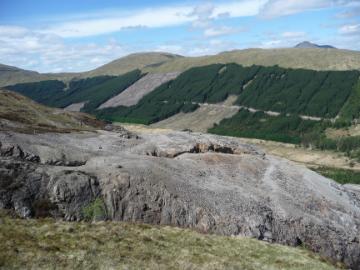The Lead Legacy
The Lead Legacy: The Relationship between Historical Mining and Metallurgical Activity, Pollution and Health, 1730-2000
This pilot project explored the value of combining the environmental record with traditional documentary evidence by examining the historical relationship between metal mining and metallurgical activities, pollution and occupational and public health using the abandoned lead mine site at Tyndrum, located in the Loch Lomond and Trossachs National Park (see image below): Open cast work and rock waste, Tyndrum Lead Mine.

Abandoned metal mining sites have unique histories. There were core similarities across the British industry in terms of extraction and the processing and smelting of ore, but within these common elements there was much variety in size, productivity, developmental strategies, patterns and length of operation, financial organisation, managerial practices and technological advances. This lack of uniformity across the industry raises fundamental questions for the study of post mining landscapes. Did some mines and/or particular periods in their history have a greater environmental impact? Is it possible to differentiate between individual contributions from mining, ore dressing and smelting to the total contamination load? What were the consequences of technological innovation? If there is was relationship between lead contamination and particular periods and/or activities at a mine, is it also possible to discern a similar correlation with ill health amongst the workforce and the local population?
Methodology: A combination of traditional archival research, record linkage and industrial and geo-archaeological techniques, including GIS, micromorphology, ICP-MS, IRL-OSL and 210Pb dating, were used to construct three detailed histories one for mining and metallurgical activity, one for lead concentrations, patterns of distribution and date of deposition, and one for the health of the workforce and local population from the original lease of the mineral rights in 1730 through to 1930. Comparison between these histories offered the potential to relate both specific activities and/or distinct periods in the history of the mine, together with adverse health events to pollution levels by date of deposition.
Brief Summary of Results: Mining and metallurgical activity at Tyndrum has left in its wake a substantial legacy of physical dereliction and chemical pollution. Clear relationships have emerged suggesting that lead values varied according to organic content of the soil material, topography, particle size and disturbance of the wastes. The dressing of the ore in preparation for smelting consistently produced the greatest concentrations of lead pollution. Pollution values at Tyndrum appear to correlate strongly with ore productivity rather than a particular period or activity in the history of its operation. Despite exposure to high lead levels, particularly at the dressing floors and a shared water supply between the mine and the local settlement until the early twentieth century, the relationship between pollution and production did not follow through strongly into health in terms of occupational and environmental poisoning.
Combining the environmental record with archive material and directing and shaping the ‘science’ to fit the historical research agenda has facilitated a much deeper and richer understanding of the relationship between lead pollution, mining activity and health that neither discipline in isolation could have achieved. For example, the record contained in the soil material bridged the gap when the documentary evidence was sparse or non-existent, whilst detailed historical accounts of activity on the site tied into the environmental record sheds light on the formation of soil material dominated by industrial origins and human influence. This integrated approach offers a future model of assessment that can be generalised to other industrial practices and geographical locations both nationally and internationally.
For further information contact Dr. Catherine Mills c.j.mills@stir.ac.uk
